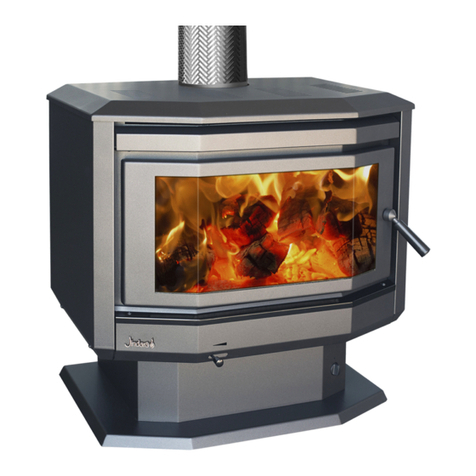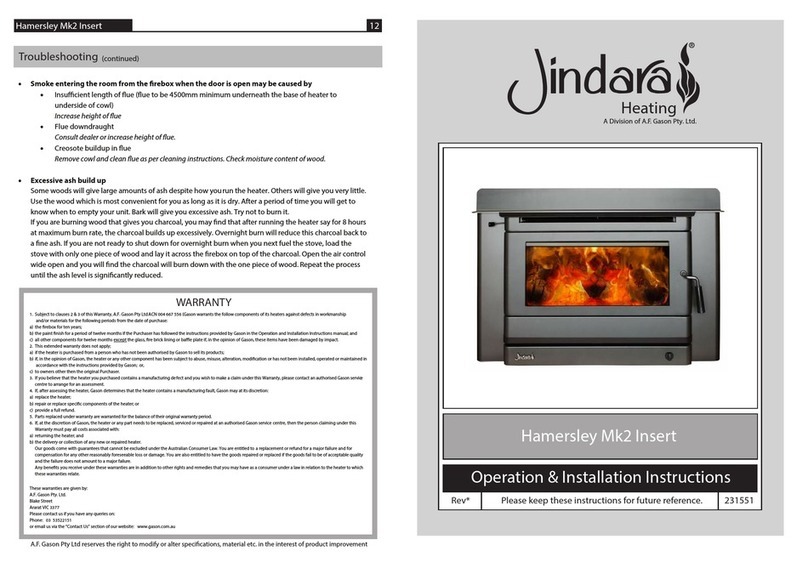Riverina SRS3 Insert 8 Riverina SRS3 Insert 5
Operating your Eureka Installation (Continued)Installation (Continued)
Fitting the Bae Plate
1. Feed bae plate through the door opening with front
edge folded up all the way to the rear of the heater.
2. Lift front over Pin A and slide towards front of heater.
3. Lift rear so bae plate is horizontal and move
towards back of heater.
4. Lower over Pin B.
5. Bae plate must be sitting on Pins A & B.
Bae Plate
Final inspection prior to use
•Ensure the bae is rmly located.
•Ensure rebrick liners – sides and back are positioned correctly.
•Check fan cord has not been damaged during transit.
•Plug in fan cord and ensure cord does not touch stove surface.
•Check all door seals are tting correctly.
“C” angle iron bracket
re bricks
bevelled edge
Take the rebricks out of the heater.They are to be placed so that they stand on end against the rear and two side walls
of the rebox.You will notice that the bricks have a bevel on one end.
Inside the rebox there is a “C” shaped angle iron rebrick retaining bracket. This is designed to sit over the bricks and
hold them in place. This should be placed in the rebox so that you see a at face of the angle iron on both sides of the
rebox and at the rear of the rebox.
Holding the “C” frame up to the top of the rebox,
insert a whole rebrick, standing it vertically with the
bevel edge pointing down and facing inwards toward
the left hand side of the rebox. Lower the left hand
side of the “C” frame onto the rebrick.Repeat with a
whole rebrick on the right hand side.
Place rebricks (3 whole rebricks) using the same
method against the back wall of the rebox.
Now place one extra whole rebrick on either side of
the rebox to complete the installation of the
rebricks. (i.e. two each side and remainder on the
back wall.)
Push each brick and “C” frame rmly against the wall
of the rebox and you are ready to light your re.
Placement of rebricks in rebox
• Select the position that you wish to install your ZCB, carefully allowing for ue clearances of 305mm in the roof
cavity (the outer ue being 255mm requires a 25mm clearance on either side to combustibles, making overall
clearance of 305mm).
• Place hearth (cement bre sheet) under the position desired for the zero box. Place the zero box into position.
• Fit ue upstands to zero box.
• Fit ue to the upstands and terminate at the required height above the roof line.
• Fit 300mm x 100mm vermin proof vent directly behind where the zero box will be located, as near as
practicable to the oor. This vent will allow air access to the zero box either from another room or external air.
Note: If installed on a timber oor, an additional two vents are required. i.e. either through the oor, one each
side of the ZCB, or alternatively, through the side wall(s) if applicable.
• Build your frame around the ZCB maintaining the clearances listed above.
• Cover the front with a 4mm cement sheet or non-combustible material for the rst 300mm above the
appliance.
• Insert your chosen appliance in the zero box and t the active ue and cowl.
• Install the mantel if required. Note: If mantel is made out of combustible material the following dimensions
must be adhered to.
ZCB installation notes
Non-combustible
hearth
Minimum 4mm thick
cement sheet, villaboard
or non-combustible
material on front face
of farming.
Figure 3. ZCB Installation Step 1.
Vent may be located
in the wall or on the
oor.
Tripleskin Flue

























